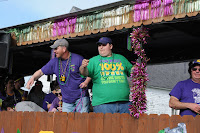I was at Eddie's Music shop in Lake Charles. After passing by the store several times, I finally decided to check out Eddie's Music House. It was located right by I-10 .near last exit before the bridge.
The man in his upper 70's, introducing himself was Eddie Shuler, owner and founder of Goldband Records and Studio. I introduced myself and told him I har recently moved to Welsh from Sweden. I was writing a column for a Swedish newspaper (Sydsvenskan). Was it possible if I came back the next day for an interview? "Sure", said Eddie and gave me a time when he would be at the store.
I knew a little about Goldband Records. While still living in Sweden, I had bought a compilation-CD, with Cookie and The Cupcakes. There was an informative booklet, accompanying the CD, so I had done some homework before hand.
The next day Eddie and his wife wrer at the store. Eddie showed me the way to his office. On the wall a gold record was hanging, plus a framed certificate from ASCAP, American Society of Composers, Authors and Publishers, certifying the Phil Phillips' Sea Of Love had been played over a million times on American radio. Shuler had arranged and recorded the song at his studio in the same complex, where the store was.
Eddie Shuler, born 1913, had moved to Lake Charles from Texas during WWII, to work in the oil industry. He was already involved in music and teamed up with The Hackberry Ramblers and played at dancehalls in southwest Louisiana and southeast Texas. He worked extra at KPLC of Lake Charles, as a disc jockey and got more involved in music. He also got interested in recording and publish records.
The first artist Eddie recorded, besides his own band The all-Star Revelers, was accordion player Iry LeJeune. Eddie Shuler got access to the radio studio in Lake Charles by paying an engineer with a pint of whiskey. The radio station cut lacquer records, which were used for commercials.
"There wasn't much French music on the radio then", Shuler explained. However, He liked what he heard and had given Iry the opportunity to play on his radio show several times. The performance was well received, so Eddie brought Iry to the studio at night to cut two numbers, Lacassine Special and Calcasieu Waltz. He brought them to a pressing plant in Houston and a few hundred 78 rpm records were pressed. Eddie loaded them up in his trunk and drove to record stores and radio stations. He eventually cut more 78's and they all better than Eddie expected.
 Eventually Eddie Shuler bought a property, where he and his wife lived, operated the store and Eddie also the studio. The studio was to the right, in the image above.
Eventually Eddie Shuler bought a property, where he and his wife lived, operated the store and Eddie also the studio. The studio was to the right, in the image above.One day Eddie was approached by a guy who worked at the air base. He had a niece, and wanted to play a tape with her singing. Eddie liked thirteen year old Dolly Parton's voice and arranged for her to come to Lake Charles and cut a record. He paid bus tickets for Dolly and her grandmother. They came down from Tennessee on a long trip on a Greyhound bus. They recorded Puppy Love, written by Dolly and her uncle Bill Owens and her released it on Goldband Records. Eventually the song was licensed by Monument Records in Nashville. "The rest is history", said Eddie.
Over the years Eddie recorded a large number of artist. like Phil Phillips, Cookie and The Cupcakes, Katie Webster, Jo-El Sonnier, Cleveland Crochet, Mickey Gilley, Rockin' Sidney, Boozoo Chavis, Van Preston (Preston Vanicor from the Welsh area), Clarence Garlow, and many more. Boozoo's Paper In My Shoe was on of the first Zydeco recordings and became a local hit.
About Cleveland Crochet from Iowa, La., Eddie said "They had a great song but they sang in French. I thought it could be a hit, with English lyrics". One day he was driving home from New Orleans the lyrics came to him. He stopped his car by the side of the car and write down the lyrics on a hamburger wrap. The song, Sugar Bee became a big hit and the first Cajun record to reach Billboard's Top 100. Unfortunately, Crochet never got financially compensated for the record's sales. The first time I heard was a cover version by Canned Heat. On the record label Ed Shuler is named as the writer.
However, Dolly Parton was very grateful for the chance he had given her by recording Puppy Love. They were still in contact when I met Eddie. He said he and his wife had been invited to Dollywood and Dolly Parton paid all their expenses.
After Eddie passed away in 2005, the Goldband complex fell in disrepair and was eventually condemned. In May 2017 the Goldband complex was torn down. I went there the day after and walked around in the rubble. I salvaged a few cassette tapes, frames for license plates and a couple of more items. If you see a vehicle with Center of Cajun Music and Eddie's Music House wrapped around the license plate it might be me out driving.
















































